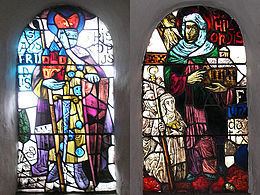Government Theocracy 1790 1.5 km² (1 sq mi) Area 150 ha | 1790 est. 3,400 Founded 1292 | |
 | ||
Thorn abbey review
Thorn Abbey or Imperial Abbey of Thorn was an imperial abbey of the Holy Roman Empire in what is now the Netherlands. The capital was Thorn. It was founded in the 10th century; independence ended in 1794, when it was occupied by French troops. The abbey was reichsunmittelbar and belonged to the Lower Rhenish-Westphalian Circle.
Contents
- Thorn abbey review
- Thorn abbey in thorn the netherlands
- Foundation
- Abbey structure
- History
- Abbesses
- References
The territory covered about 1.5 square kilometers with 3400 inhabitants in 1790.
Thorn abbey in thorn the netherlands
Foundation
Details of the founding of the abbey are not clear. According to some sources, the abbey was founded by Countess Hilswind in 902 for herself and her daughter Beatrix. She donated the necessary land, which had been personal property, given to the Countess by King Zwentibold. Other sources claim a Benedictine double monastery was founded by Bishop Ansfried of Utrecht and his wife Hereswint in 925. A Romanesque abbey church was built in 992; some sources give this as the year the Abbey was founded.
Abbey structure
The collegiate women came only from the high nobility. It is likely that Thorn had belonged to the Benedictine order originally. It probably changed, however, in the 12th century, to a free secular ladies' abbey. In 1310, the secular cannons of the Abbey stressed their secular status and they claimed to never have been Benedictine.
In the 18th century, collegiate ladies were, in principle, required to reside in the Abbey all year, except for at most six weeks per year. However, for 600 florins, ladies could buy themselves free. In theory, free ladies were still required to provide six weeks of choral service; this was not always observed in practice. Some ladies held positions in several abbeys. This possibility of buying freedom appears to have been used frequently. Maria Josepha of Hatzfeld and Gleichen, for example, was a member of the abbeys at Thorn and Essen for 46 years. During this time, she resided in Essen Abbey for four years, but never in Thorn.
The abbey district contained a curia building for the Deachoness and five house for the ladies. In the 14th Century, a new Gothic Abbey Church was built. Some of the ladies built houses outside the abbey district.
History
The imperial immediacy of the abbey was confirmed in 1292 by King Adolf of Nassau. Under Emperor Maximilian I, the abbey was under the special imperial protection. In the imperial matriculation register at Worms, the Abbey was recorded as a reichsunmittelbar area. The matriculation duties, however, were transferred to the Counts of Lippe.
The abbey was a member the Lower Rhenish-Westphalian Circle and the Rhenish College of Imperial Prelates.
In the 17th century the governorship of the Spanish Netherlands sought to restrict the imperial immediacy. The abesses resisted these attempts successfully. In the 18th century, the abbess held the title of Princess. Several abbesses were simultaneously head of Essen Abbey.
The territory was conquered by French troops in 1794 and formally annexed by France in 1795. In 1815, the Congress of Vienna awarded the territory to the Kingdom of the United Netherlands.
